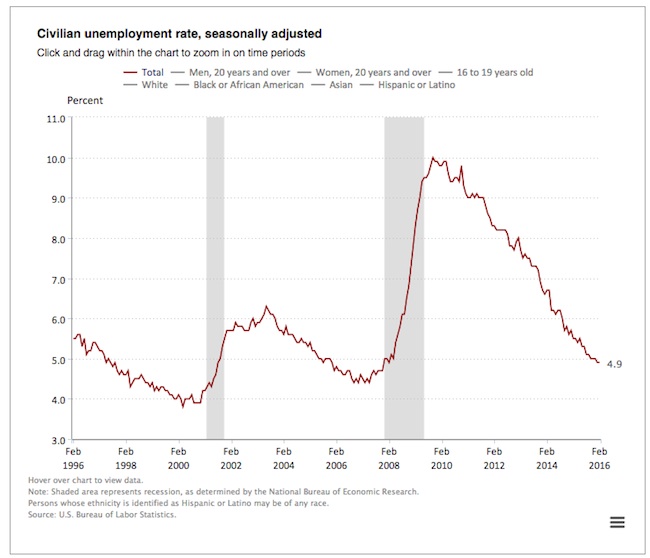U.S. adds 242,000 jobs in February
Construction industry gains 19,000 jobs for month; sector gains 250,000 jobs in last 12 months.
Total nonfarm payroll employment increased by 242,000 in February, and the unemployment rate was unchanged at 4.9 percent, the U.S. Bureau of Labor Statistics reported today. Employment gains occurred in health care and social assistance, retail trade, food services and drinking places, and private educational services. Job losses continued in mining.
Household Survey Data
In February, the unemployment rate held at 4.9 percent, and the number of unemployed persons, at 7.8 million, was unchanged. Over the year, the unemployment rate and the number of unemployed persons were down by 0.6 percentage point and 831,000, respectively.
Among the major worker groups, the unemployment rates for adult men (4.5 percent), adult women (4.5 percent), teenagers (15.6 percent), Whites (4.3 percent), Blacks (8.8 percent), Asians (3.8 percent), and Hispanics (5.4 percent) showed little or no change in February.
The number of long-term unemployed (those jobless for 27 weeks or more) was essentially unchanged at 2.2 million in February and has shown little movement since June. In February, these individuals accounted for 27.7 percent of the unemployed.
The employment-population ratio edged up to 59.8 percent over the month, and the labor force participation rate edged up to 62.9 percent. Both measures have increased by 0.5 percentage point since September.
The number of persons employed part time for economic reasons (also referred to as involuntary part-time workers) was unchanged in February at 6.0 million and has shown little movement since November. These individuals, who would have preferred full-time employment, were working part time because their hours had been cut back or because they were unable to find a full-time job.
In February, 1.8 million persons were marginally attached to the labor force, down by 356,000 from a year earlier. (The data are not seasonally adjusted.) These individuals were not in the labor force, wanted and were available for work, and had looked for a job sometime in the prior 12 months. They were not counted as unemployed because they had not searched for work in the 4 weeks preceding the survey.
Among the marginally attached, there were 599,000 discouraged workers in February, down by 133,000 from a year earlier. (The data are not seasonally adjusted.) Discouraged workers are persons not currently looking for work because they believe no jobs are available for them. The remaining 1.2 million persons marginally attached to the labor force in February had not searched for work for reasons such as school attendance or family responsibilities. (See table A-16.)
Establishment Survey Data
Total nonfarm payroll employment increased by 242,000 in February. Job growth occurred in health care and social assistance, retail trade, food services and drinking places, and private educational services. Mining employment continued to decline. (See table B-1.) Health care and social assistance added 57,000 jobs in February.
Health care employment increased by 38,000 over the month, with job gains in ambulatory health care services (+24,000) and hospitals (+11,000). Over the past 12 months, hospitals have added 181,000 jobs. In February, employment rose by 19,000 in social assistance, mostly in individual and family services (+14,000).
Retail trade continued to add jobs in February (+55,000). Employment rose in food and beverage stores (+15,000) and other general merchandise stores (+13,000). Retail trade has added 339,000 jobs over the past 12 months.
Food services and drinking places added 40,000 jobs in February. Over the year, employment in the industry has grown by 359,000.
Employment in private educational services rose by 28,000 in February, after edging down by 20,000 in the prior month.
Construction employment continued to trend up in February (+19,000), with a gain of 14,000 in residential specialty trade contractors. Employment in construction was up by 253,000 over the past 12 months, with residential specialty trade contractors accounting for about half of the increase.
Employment in mining continued to decline in February (-19,000), with job losses in support activities for mining (-16,000) and coal mining (-2,000). Since a recent peak in September 2014, mining has shed 171,000 jobs, with more than three-fourths of the loss in support activities for mining.
Employment in other major industries, including manufacturing, wholesale trade, transportation and warehousing, financial activities, professional and business services, and government, showed little change over the month.
Workweek and earnings
The average workweek for all employees on private nonfarm payrolls declined by 0.2 hour to 34.4 hours in February. The manufacturing workweek was unchanged at 40.8 hours, and factory overtime was 3.3 hours for the third month in a row. The average workweek for production and nonsupervisory employees on private nonfarm payrolls edged down by 0.1 hour to 33.7 hours.
In February, average hourly earnings for all employees on private nonfarm payrolls declined by 3 cents to $25.35, following an increase of 12 cents in January. Average hourly earnings have risen by 2.2 percent over the year. In February, average hourly earnings of private-sector production and nonsupervisory employees were unchanged at $21.32.
The change in total nonfarm payroll employment for December was revised from +262,000 to +271,000, and the change for January was revised from +151,000 to +172,000. With these revisions, employment gains in December and January combined were 30,000 more than previously reported. Over the past 3 months, job gains have averaged 228,000 per month.
















